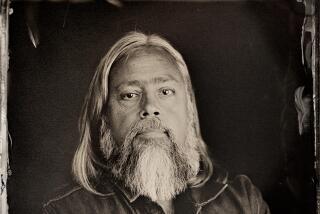The Rhythm of the Sioux : AT THE RIVER’S EDGE, <i> By Elizabeth Cook-Lynn (Arcade: $17.95; 147 pp.) </i> : THE POWER OF HORSES And Other Stories, <i> By Elizabeth Cook-Lynn (Arcade: $17.95; 131 pp.) </i>
- Share via
John Tatekeya “(Tah-TAY-kee-ya),” the hero of Elizabeth Cook-Lynn’s novel “At the River’s Edge,” notes that his lover Aurelia has “the ability to adapt the rhythm of one language to change the sound of another. And so, when she talked in English she often used the sounds of Dakotah, the cadence and tone of Dakotah speech.” In this passage, Cook-Lynn, a member of the Crow Creek Sioux tribe, has described what is most distinctive and effective about her own writing voice. If you saw “Dances With Wolves,” you heard the Sioux language spoken; here you’ll recognize a similar, staccato-like cadence in her wonderful prose. When Cook-Lynn slips in the occasional Dakota phrase, you will want to hear the words spoken out loud: “ ‘ Tokiya la he ?’ she asked. ‘Where are you going?’ ”
Storytelling traditionally was taken very seriously by Native Americans, as it was intimately tied to tribal belief systems. The storytellers themselves had an elevated status, and often were thought to possess special powers. They were the teachers and visionaries. They carried a grave responsibility: the complete history of a culture. Even the youngest children soon came to understand that every story, even the silliest, contained a history lesson or an illustration of values or the spiritual dimension in the lives of the people.
Cook-Lynn is a storyteller in the tradition of Native America. She is not concerned with multidimensional characterization or exciting plots. Essentially, her stories are lessons--about morality, tradition, learning to live within a culture with values counter to your own. Her briefest sketches in “The Power of Horses,” such as “Mahpiyato” and “Bennie,” demand to be read aloud. Enigmatic, poetic, they possess a true sense of spiritual mystery.
Cook-Lynn’s lean, terse voice captures the essence of contemporary Sioux reservation life in a few deliberate, delicate strokes, wasting not a word, not an image. She presents a stark picture of poverty, alcoholism, dysfunctional families, reservation towns that feel as empty as a local’s wallet. Her language is as spare as a Northern Plains wintry landscape. There’s no denying the power of even the simplest of her images:
“You think you see old women leaving marked trails in the tall burnt grass as they carry firewood on their backs from the river, and you think you hear the songs they sang to grandchildren, and you feel transformed into the past. But then, winter comes. The earth freezes solid. And you wish for July and the ripe plums and the sun on your eyelids.”
Cook-Lynn’s slender collection of elegant and powerful short stories, “The Power of Horses,” was published in 1990; her publisher, Arcade, published her new novel this past summer. “At the River’s Edge” tells the story of an Dakota cattleman in the late 1960s trying to find justice within the American legal system and how this trial changes his life. Tatekeya has had about 100 head stolen and finds himself the one on trial.
“John’s experience with the law was considerable. He had been hauled in by the police many times. The tribal police, municipal cops, the state patrol. Driving under the influence, speeding, resisting arrest, illegal parking, no license tabs, assault . . . “ Now he’s the one bringing the charges. “The white man has always stolen from the Sioux, he thought. . . . First it is our land, then our way of life, our children, and finally even the laws of our ancestors. And now this white man, the son of my white neighbors, has stolen my goddamn cows.”
Southern Californians may be not as knowledgeable of the recent history of the Sioux as Midwesterners. Cook-Lynn refers to but does not illuminate details about the federal water project that dammed sections of the Missouri River, flooding portions of Sioux land.
Also, deeper in the background of the novel are the federal government’s termination policies in the late 1950s and early ‘60s that encouraged Indians to quit the reservations and find work and a new way of life in cities. What they encountered was racism, unemployment and urban poverty. Many chose to return to the reservation by the late ‘60s, despite terrible rural conditions. In the cities they possessed little that defined them as Sioux (or any other particular tribal identity). People sharing a diminishing cultural tie were brought back together on the reservations. They once again had the Sun Dance, sacred songs, the land their ancestors had lived and died on--all vital connections to a reawakening historical identity. In the late ‘60s, the American Indian Movement (AIM) was gaining a political foothold on the reservations that would eventually lead to the violent confrontation with the federal authorities at Wounded Knee. Tatekeya’s experience foreshadows the tragedy of AIM.
Cook-Lynn makes us see the history behind and ahead of her character John Tatekeya. This is a ploy she uses in some of the stories in the “Power of Horses” as well, reminding us that we are in the presence of a storyteller manipulating characters for the benefit of the lessons at hand. We know that he will grow old, blind, return to the old ways. What’s paramount here is how the trial will turn Tatekeya in the direction we know he will go. It is what unkind, uninvited events will teach Tatekeya that counts.
Juxtaposed with John is his lover, Aurelia, an independent, beautiful woman half his age, who, despite her alcoholism, has retained a connection to the ancient traditions: “The desultory telling of stories by the old people with whom she lived informed her daily life and gave meaning to the world she knew.” The results of John’s trial force each of these two into opposing destinies: John is led back into the supportive circle of family and tradition. Aurelia loses her tenuous connection to what had sustained her: “She now began to accept . . . that the stories of the pipe-stone quarries of her people were apocryphal. Like the sacred grounds of Palestine, they could no longer symbolize the final restoration in the modern world.”
Anger--and irony--is evident in many of the stories, as well as in the novel. Cook-Lynn is as political as she is poetic. Wasichus --whites, but essentially all non-Indians--often come across as hostile and murderous (In the story “Last Days of a Squaw Man,” Gracie has a white father who abuses her and her siblings; at his funeral they abuse each other), pathetic, arrogant and insensitive (Youngest Daughter, in the story “A Visit From Reverend Tileston,” hopes that the white missionary knows about “the four blanket carriers who once helped (her uncle) find his way home from a long and difficult journey.”)
The American legal system, modern technology, Christianity, scholarships, prison--none of these has an impact, finally, on the integrity of what is essentially Indian, posits the author. But, Cook-Lynn is saying, a personal peace must be made with this other, imposing world:
“The magic acts of white men don’t seem to work well on Indians, I thought, and the stories they tell of our collective demise have been greatly exaggerated; or, to put it into the vernacular of the myth tellers of my childhood, ‘ Heha yela owi hake ,’ this the appropriate ending to the stories which nobody was expected to believe anyway.”
Believe in the stories, Elizabeth Cook-Lynn tells her audience, Indian and non-Indian. It’s hard not to believe in such remarkable prose and vision.
More to Read
Sign up for our Book Club newsletter
Get the latest news, events and more from the Los Angeles Times Book Club, and help us get L.A. reading and talking.
You may occasionally receive promotional content from the Los Angeles Times.










